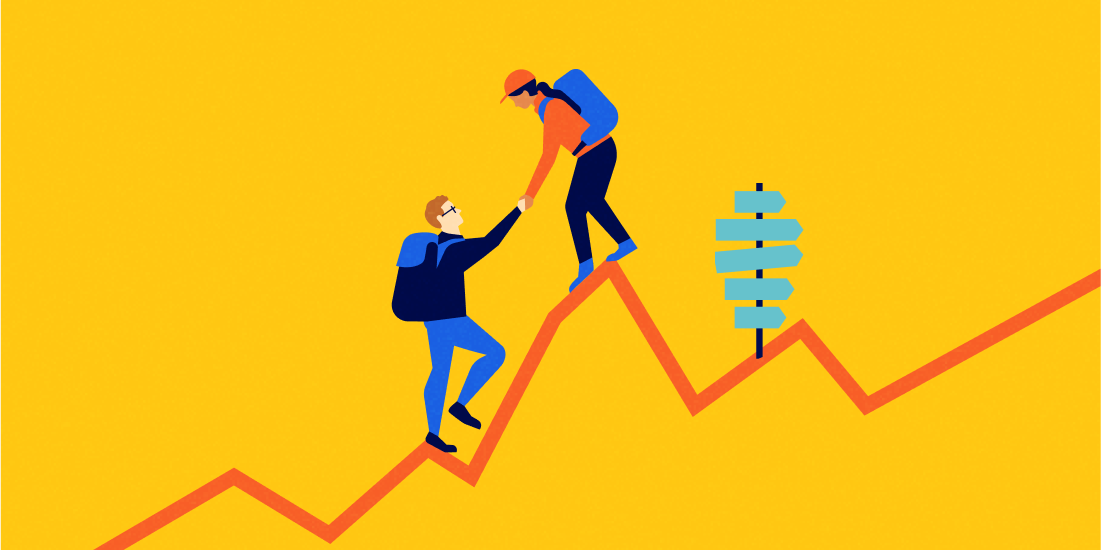Ben Bakkum, CFA, CFP®
Meet our writer
Ben Bakkum, CFA, CFP®
Sr. Investment Strategist, Betterment
Ben is a member of Betterment's Investing team in the role of Sr. Investment Strategist. Previously, he worked on the data team at GiveDirectly, a nonprofit NGO that operates cash transfer and basic income programs. Prior to GD, he worked on the Private Bank Chief Investment Officer’s team at J.P. Morgan, contributing to the team's research, analysis, and content creation. Ben studied finance and history at the University of Virginia and is a CFA® charterholder and a CERTIFIED FINANCIAL PLANNER™ professional.
Articles by Ben Bakkum, CFA, CFP®
-
![]()
Can a portfolio be too simple?
Can a portfolio be too simple? Dec 10, 2025 2:22:50 PM Total market funds offer simplicity, but by unbundling asset classes—and adding Betterment’s automation—you can make your money work harder. Key takeaways Single-fund portfolios are easy to build, but they’re harder to optimize for taxes and costs. Using multiple funds adds the flexibility to fine-tune allocations and unlock savings. Betterment’s automation and expert-built portfolios give you the best of both worlds: easy to invest in, and built to work harder. If you’re looking to build long-term wealth, you could do worse than investing in one or two low-cost, globally-diversified total market funds. But you could potentially do better—and spend less of your limited bandwidth—by using a few more pieces and putting our technology to work in your favor. That’s the value of Betterment’s automated investing and expert-built portfolios, and it begins with (surprise!) tax optimization. Harvesting losses for tax wins, and putting your assets in the right place Targeting more than a date Splitting hairs on fund fees, so customers can save millions Harvesting losses for tax wins, and putting your assets in the right place Tax-loss harvesting can help give your taxable investing an edge, and it happens when you sell an asset for a loss and replace it with a similar one. The downside of a total market fund, however, is you have to wait for the entire fund to experience a loss. If only one piece of it dips, you can’t unbundle the assets and harvest that specific piece. It’s sell all, or sell nothing. That’s a big reason why we switched from using a single fund for U.S. stocks in our Betterment-built portfolios, opting instead for three separate funds representing small, medium, and large-sized U.S. companies. If one of them presents a harvesting opportunity, we can swap it for a similar alternative. The second area where larger fund lineups shine is asset location, or strategically divvying up your portfolio’s assets among traditional, Roth, and/or taxable accounts. Stocks with the highest potential for growth, for example, are often better-suited for traditional accounts. Let them grow tax-free, the thinking goes, then settle up with Uncle Sam when you’re retired and more likely to be in a lower tax bracket. Our mathematically-rigorous spin on asset location is called Tax Coordination, and it’s yet another way our automated investing helps you keep more of what you earn. To start taking advantage of it, simply open any combination of the three account types above and follow a few easy steps. Targeting more than a date One of the most common single-fund options for retirement savings are target date funds. They date back to the 90s and became the default option in many 401(k) plans starting in the late 2000s. The growth of target date funds has been a good thing for investors, helping move the industry toward lower-cost, automated investing. Prior to their arrival, advisors had to manually adjust the asset allocations or “glide paths” of portfolios over time. Similar to total market funds, however, the bundling of target date funds brings with it some constraints. The first constraint is their relative lack of choice. Say you were born in 1988 and are targeting a traditional retirement age of 62. Most target date fund managers give you one option—the 2050 fund. Our automated investing, on the other hand, gives you more than a handful of portfolios to choose from, including ones tailored for social responsibility and innovation. More funds also creates more levers to fine-tune your exposure, helping manage risk in all sorts of situations. Take bond-heavy portfolios as an example. Rising interest rates can erode their value, so we dial up their exposure to short-term corporate debt and U.S. Treasuries specifically to help hedge against that risk. Splitting hairs on fund fees, so customers can save millions The relatively high cost of target date funds has been trending downward, and many total market funds can be found for expense ratios of less than 0.1%. But we can squeeze out even more savings by splitting a portfolio up and shopping for better deals. A single one hundredth of a percentage point in fund fees (what’s referred to as a “basis point” or “bip” in investing lingo) may not sound like much, but we owe it to our customers to make every one count. You could pay 6 basis points (0.06%), for example, for a total world stock fund like VT. Or you could pay one-third of that for your U.S. stock allocation by breaking it up into three funds (SPYM, SPMD, and SPSM) like we do with our Core portfolio and others. Using our customers’ nearly $20 billion worth of U.S. stocks as an example, that would amount to roughly $7.6 million in combined savings each year. Flexibility to stretch your investing dollars even farther A simple portfolio can be a great place to start, but it’s not always where your money works hardest. By strategically using a few more funds, we can sprinkle tax advantages on more of your investing, optimize across account types, and potentially unlock even more cost savings. All automatically. You get the simplicity you want, but with our tech doing the heavy lifting behind the scenes. -
![]()
The pitfalls of comparing portfolio returns
The pitfalls of comparing portfolio returns Sep 2, 2025 1:30:06 PM How to take stock of your stocks (and bonds)—here, there, everywhere. Investing can feel like a leap of faith. You pick a portfolio. You deposit money. Then, you wait. Trouble is, it takes a while for compound growth to do its thing. Using the Rule of 72 and historical stock returns, it takes roughly a decade for every dollar invested to double. That’s a lot of time for second-guessing. You may peek at your portfolio returns and wonder, “Could I be doing better?” Don’t worry; it’s normal to question whether we’re making the right choices with our money. But comparing different portfolios can be tricky. Variables abound. There’s the composition of the portfolios themselves, but also their fees and tax treatments. So whether you’re sizing us up with rival money managers, or with the stock indexes you see most often in the news, we’re here to help you level set. The ABCs of apples-to-apples comparisons Let’s start with a statistic we’re quite proud of: Since launching in 2011, our 90% stock Core Portfolio has delivered over 9.0% returns*. Those are the returns of real Betterment customers, minus fees, and taking the timing of deposits and withdrawals out of the equation. This helps focus more on the performance of the portfolio itself. *As of 12/31/2024, and inception date 9/7/2011. Composite annual time-weighted returns: 12.7% over 1 year, 7.9% over 5 years, and 7.8% over 10 years. Composite performance calculated based on the dollar-weighted average of actual client time-weighted returns for the Core portfolio at 90/10 allocation, net of fees, includes dividend reinvestment, and excludes the impact of cash flows. Past performance not guaranteed, investing involves risk. So, is 9.0% good? Well, it depends on the comparison. Stock indexes like the S&P 500 and Dow Jones dominate the news, but they’re hardly comprehensive. For one, they exclude bonds, a lower-yield staple of many portfolios. There’s a reason why regardless of the portfolio, we recommend holding at least some bonds. They help temper market volatility and preserve precious capital. Secondly, popular indexes also largely ignore international markets. The S&P, for example, typically represents less than half the value of all investable stocks in the world. Our globally-diversified portfolios, meanwhile, spread things out in service of a smoother investing journey. We're built for the long run, and history has shown that American and International assets take turns outperforming each other every 10-15 years. So the modest amount of international exposure in many of our portfolios means this: you're in a better position to profit when the pendulum swings the other way. Now, taking all of this to heart isn't easy. Not when the S&P returns 20% in a given year. At moments like these, it’s perfectly normal to feel FOMO when looking at the returns of your globally-hedged investing. To keep the faith, it helps to keep the right benchmark(s) in mind. Not all diversification is created equal We’re not alone in offering globally-diversified portfolios. But two portfolios, even with similar stock-to-bond ratios, can take very different paths to the same end goal. Tax optimization, market timing, and fund fees can all impact your investing’s bottom line as well. Some investors compare providers by investing a little with each, waiting a few months, then comparing the balances. This sort of trialing, however, may not tell you much. When it comes to our portfolios, you can find better comparisons in two particular ETFs that seek to track a wide swath of the market: ACWI for stocks and AGG for bonds. See how your Betterment portfolio stacks up against them in the Performance section for any goal or account. Simply scroll down to “Portfolio returns,” click “Add comparison,” and pick from the available allocations of stocks and bonds. We show your “Total return” by default at Betterment, otherwise known as the portfolio’s total growth for a given time period. You can also see this expressed as an “Annualized” return, or the yearly growth rate you often see advertised with other investments. Putting your performance in perspective Comparison may be the thief of joy, but it’s okay, prudent even, to evaluate your investing returns on occasion. Once or twice a year is plenty. The key is to steer clear of common pitfalls along the way. Like comparing your globally-diversified apple to someone else’s all-U.S. orange. Or cherry-picking a small sample size instead of a longer, more-reliable track record. It’s easier said than done. That’s why we bake more relevant comparisons right into the Betterment app. It’s also why we produce content like this. Because if there’s a silver lining to the slow snowballing of compound growth, it’s that you have plenty of time to brush up on the basics. -
![]()
A big bill, ballooning debt, and a weakening U.S. dollar
A big bill, ballooning debt, and a weakening U.S. dollar Aug 20, 2025 5:00:00 AM The “Big Beautiful Bill” could take our national debt to unseen levels. Will international markets reap the rewards? In early July, Congress passed the One Big Beautiful Bill Act (OBBBA), and while its full impact won’t be felt for some time, two key aspects of it seem at odds. The first is that it permanently extends certain provisions of the 2017 Tax Cuts and Jobs Act, including lower individual tax rates and higher standard deductions. The similar corporate and individual income boosting nature of the OBBBA has likely played some part in the rally in stocks since April. Yet as much as markets eat this type of legislation up, it comes with a strong risk of heartburn. That’s because the second major takeaway from the bill is that it’s forecasted to add around $4 trillion to the national debt over the next 10 years. The chart below shows the national debt as a share of U.S. GDP, and the dashed orange line shows the estimated trajectory after the passage of the OBBBA. It’s projected to grow to levels unlike anything we’ve seen before, including World War II. So what does all this mean for markets? Burgeoning debt means a larger supply of Treasury bonds that the Federal government uses to borrow. This may in turn cause interest rates to rise in the long term as bond investors with creeping doubts about our country’s fiscal situation demand a lower price and a higher yield for its debt. There are also estimates that the bill may be a drag on economic growth as bigger deficits and government borrowing start to crowd out private investment. We may not fully know the outcomes of tariffs and the OBBBA for some time, but one place we’re seeing policy changes already is in demand for the U.S. dollar. Since January, we've seen a significant weakening in the dollar relative to other major currencies as the trade war and fiscal outlook have shaken confidence in U.S. markets. The dollar is down almost 10% over the last six months, the largest decline in such a span in over 30 years. A weaker dollar has the effect of making imports in the U.S. more expensive for consumers, but it also makes international investments worth more, as the values of companies overseas have gone up in dollar terms just by virtue of their local currencies strengthening relative to the dollar. This currency dynamic has contributed to the strong returns of our globally-diversified portfolios in 2025. The first half of the year offers a case study in the benefits of being globally-diversified, which smooths out volatility as various parts of the world take turns outperforming each other. It may not make the news headlines any less scary, but it can benefit your investing’s bottom line. Cash Reserve offered by Betterment LLC and requires a Betterment Securities brokerage account. Betterment is not a bank. FDIC insurance provided by Program Banks, subject to certain conditions. Learn more. -
![]()
With U.S. markets struggling, is now the time to go global?
With U.S. markets struggling, is now the time to go global? May 7, 2025 6:00:00 AM Here’s the case for keeping a little international exposure in your investing. U.S. stocks have been the envy of the world since 2010, generating nearly 4 times the returns of their international counterparts. But since April 2, President Trump’s tariff policies have dragged down U.S. stocks and left investors unnerved. Does this mean the U.S. market is toast? Certainly not, but it does signal a potential shift in foreign investment, which means that if you haven’t already, now may be the time to consider diversifying globally. And we can help on that front. Hello, world. We're here to invest. The U.S. market is big, but it’s not the only game in town. Hundreds of billions of dollars in assets trade hands in international markets each day. It's why the Betterment Core portfolio, built on the idea that more diversification equals less risk, roughly mirrors the relative weights of global markets. Like we mentioned above, the U.S. market has been on an absolute tear the past 15 years, and even more so since 2020. This record winning streak has fueled our home bias, or the tendency for American investors to favor American markets. But history shows a pendulum that typically swings back and forth every 5 to 10 years. International markets outperformed in the 2000s, for example, and they saw a huge spike in the late 80s. So what’s an investor to do? If you're investing for the long term, the odds are good the U.S. market will hit at least one extended rough patch in that time. And in that scenario, a globally-hedged portfolio will very likely smooth out your returns from year to year. We’re seeing this start to play out in 2025, with the Betterment Core portfolio and its global diversification outperforming many common U.S.-only funds. As of 5/2/2025. Betterment Core composite actual time-weighted returns: 10.52% over 1 year, 12.35% over 5 years, and 7.30% over 10 years as of 5/2/2025. Composite performance calculated based on the dollar weighted average of actual client time-weighted returns for the Core portfolio at 90/10 allocation, net fees. Performance not guaranteed, investing involves risk. That being said, diversification is a sliding scale. There is no pass/fail, no good or bad. If you’re looking for a little more international exposure, but not to the extent of one of our pre-built portfolios, you can invest in our Flexible portfolio and tailor your allocation as you see fit. But if you’re less experienced in investing, and simply want an option that requires less work, then let us do the recalibrating for you. We update our pre-built portfolios annually, finetuning our U.S. and international exposures based on the latest long-term projections. We can’t predict when the global tides will turn, but we can make sure you don’t miss out when they do. -
![]()
How we make market downturns less scary
How we make market downturns less scary Apr 7, 2025 12:12:58 PM And how it can benefit your investing’s bottom line. The recent round of tariffs and trade wars have roiled markets, offering the latest example of investing’s inherent volatility. The fact that market drops do happen, and happen with some regularity, means that managing them is not only possible but paramount. "It's not about whether you're right or wrong," the investor George Soros once quipped. "But how much money you make when you're right, and how much you lose when you're wrong." Mitigating losses, in other words, matters just as much as maximizing gains. And this is true for two important reasons: The bigger the loss, the more tempted you may be to sell assets and lock in those losses. The bigger the loss, the less fuel for growth you have when the market does rebound. Point A is psychological, while Point B is mathematical, so let’s take each one separately. In the process, we’ll explain how we build our portfolios to not only weather the storm, but soak up as many rays as possible when the sun shines again. Smoothing out your investing journey Imagine you’re given a choice of rides: one’s a hair-raising roller coaster, the other a bike ride through a series of rolling hills. Sure, thrill seekers may choose the first option, but we think most investors would prefer the latter, especially if the ride in question lasts for decades. So to smooth things out, we diversify. Owning a mix of asset types can help soften the blow on your portfolio when any one particular type underperforms. Our Core portfolio, for example, features a blend of asset types like U.S. stocks and global bonds. The chart below shows how those asset types have performed individually since 2018, compared with the blended approach of a 90% stocks, 10% bonds allocation of Core. As you can see, Core avoids the big losses that individual asset classes experience on the regular. That’s one reason why through all the ups and downs of the past 15 years, it’s delivered 9% composite annual time-weighted returns1, and that’s after fees are accounted for. 1As of 12/31/2024, and inception date 9/7/2011. Composite annual time-weighted returns: 12.7% over 1 year, 7.9% over 5 years, and 7.8% over 10 years. Composite performance calculated based on the dollar-weighted average of actual client time-weighted returns for the Core portfolio at 90/10 allocation, net of fees, includes dividend reinvestment, and excludes the impact of cash flows. Past performance not guaranteed, investing involves risk. Core’s exposure to global bonds and international stocks has also helped its cause, given their outperformance relative to U.S. stocks year-to-date amidst the current market volatility of 2025. A smoother ride can take your money farther Downside protection is all the more important when considering the “math of losses.” We’ll be the first to admit it’s hard math to follow, but it boils down to this: as a portfolio’s losses rack up, the gains required to break even grow exponentially. The chart below illustrates this with losses in blue, and the gains required to be made whole in orange. Notice how their relationship is anything but 1-to-1. This speaks to the previously-mentioned Point B: The bigger your losses, the less fuel for growth you have in the future. Investors call this “volatility drag,” and it’s why we carefully weigh the risk of an investment against its expected returns. By sizing them up together, expressed as the Sharpe ratio, we can help assess whether the reward of any particular asset justifies its risk. This matters because building long-term wealth is a marathon, not a race. It pays to pace yourself. And yet, there will still be bumps in the road Because no amount of downside protection will get rid of market volatility altogether. It’s okay to feel worried during drops. But hopefully, with more information on our portfolio construction and automated tools like tax loss harvesting, you can ride out the storm with a little more peace-of-mind. And if you’re looking for even more reassurance, consider upgrading to Betterment Premium and talking with our team of advisors. -
![]()
Three burning questions for the market in 2025
Three burning questions for the market in 2025 Jan 7, 2025 10:09:29 AM Are U.S. stocks overvalued? Will AI pan out? Do markets care who’s in the White House? Investors are starting to feel a healthy dose of cognitive dissonance—that grating feeling when two beliefs you hold don't quite line up. On one hand, the U.S. market is soaring on the back of AI optimism and potential tax cuts. And on the other, companies’ stock prices, relative to their actual earnings, are starting to loosely resemble the run-up to the Dotcom bubble of the late 90s. So which belief will win out in 2025: boom or bust? Let's parse this conflicted outlook by examining three questions in particular: Are U.S. stocks overvalued? Will AI pan out? Do markets care who’s in the White House? Are U.S. stocks overvalued? Around this time last year, we said the booming market at the time might keep going if the Fed lowered interest rates in response to cooling inflation. Interest rates did tick down, and boy, did markets take notice. Through the end of November 2024, a 90% stock Betterment Core portfolio returned roughly 17.6% year-to-date. Such a run, however, begs speculation of yet another reversal, a swing of the pendulum toward less frothy valuations and a drawback in portfolio returns. The S&P 500 currently costs about 25 times more than what those companies are expected to bring in over the next 12 months. For comparison, this average “price-to-earnings” ratio over the last 35 years has been 18x. Taking the perspective of a long-term investor, however, these ratios matter less than you may think. So long as you stay invested for more than a few years, chances are the market as a whole may “grow” into its valuation. Remember 2021 when a group of tech-centric, risky stocks were darlings of the pandemic and shot to the moon? Analysts rightly called foul—those kinds of valuations shouldn’t be sustainable. But within a few years the market was setting fresh all-time highs. An investor who had sold or stayed on the sidelines would've missed out on all that growth. So if you’re tempted to sell “high” right now, remember this: On average, investing at all-time highs hasn’t resulted in lower future returns compared to investing on any given trading day. On the contrary, buying when the market has never been higher leads to slightly higher average returns in the long run. You can never be sure exactly when a growth cycle will end. Will AI pan out? A big driver of this bull market has been optimism surrounding artificial intelligence and the big tech companies powering it, like Amazon, Google, and the computer chip-maker Nvidia. They’ve rallied big-time over the last 12 months, and as a result, they make up an increasingly large share of the U.S. and global stock market. A debate, however, surrounds their outperformance and the hoopla around AI in general. Some analysts argue that a good amount of AI investment won’t ultimately prove fruitful, while others foresee significant boosts to productivity and profits. There’s that grating feeling again—the potential of revolutionary upside sitting right next to worries that it’s mostly hype. In the face of uncertainty, all one can do to lower their risk is hedge their bets and diversify. Our portfolios’ stock allocations take this to heart, offering significant exposure to Big Tech, while also investing in European, Japanese, and emerging markets. It’s these less expensive equities that provide a potential buffer in the event AI’s ambitions fall short. Do markets care who’s in the White House? Right now, markets aren’t sure exactly what to make of President-elect Trump’s proposed economic agenda. Promises of corporate tax cuts, while fueling the recent surge in stocks, could in practice increase inflation. Same goes for tariffs and mass deportation. And rising inflation could in turn pause or reverse the recent trend in interest rate cuts. But until more details emerge, or the policies themselves are actually put into practice, we won’t know their full effect. Instead of sitting back and anxiously waiting, we suggest taking a look at the chart below. It shows that markets tend to rise over time regardless of which party holds the presidency. Maintaining a consistent, diversified investment approach is the best way to navigate political and economic cycles. That, and maybe cooling it a bit on your news consumption. So what now? As always, it’s impossible to know exactly how long each growth cycle will last, so consider erring on the side of staying invested. If you find yourself sitting on too much cash, now might be the time to put it to work in the market. You can invest it as a lump sum, which research shows may offer higher potential returns. Or you can sprinkle it into a portfolio over time. Most importantly, however the market performs in 2025, we suggest zooming out and reminding yourself you’re in it for the long haul. -
![]()
5 financial tips: What to do when rates fall
5 financial tips: What to do when rates fall Sep 10, 2024 2:54:29 PM Interest rates are falling but that doesn’t mean the sky is falling when it comes to your finances. Here are 5 tips to help you weather a falling-rate environment. Table of contents: Why does the Federal Reserve cut rates? What happens to cash, stocks, and bonds when rates drop? 5 financial tips to consider when the Fed cuts rates What should you do with your money when rates fall? It can be hard to know what to do with your money when the Federal Reserve (aka the Fed) cuts interest rates. But we’ve got you covered. In this article, we’ll explore why the Fed cuts rates, what happens when they do, and most importantly, what you can do to keep your finances on track. Why does the Federal Reserve cut rates? The Fed cuts interest rates for various reasons related to stimulating economic growth and addressing concerns about the economy's performance. As we look into the future, some of the specific reasons why the Fed might decide to cut interest rates include: Curb an economic slowdown: If the economy is showing signs of slowing down, such as a decline in GDP growth or an increase in the unemployment rate, the Fed may cut interest rates to encourage borrowing and spending to boost economic activity. Manage inflation: When inflation is stabilized or falling, the Fed might cut interest rates to stimulate demand and help achieve its target inflation rate. Lower interest rates make borrowing cheaper, which can lead to increased consumer spending and business investments. Stabilize financial markets: In times of market volatility, the Fed may cut interest rates to calm investors and restore confidence in the economy. Lower interest rates can reduce the risk of defaults on loans. Support job growth: The Fed aims to keep the labor market healthy by promoting job creation and wage growth. By cutting interest rates, the central bank makes it easier for businesses to hire workers and invest in their employees' future. What happens to cash, stocks, and bonds when rates drop? In a rate-cut environment, the performance of high-yield cash accounts, stocks, and bonds can be affected in various ways: Cash account returns: When interest rates fall, high-yield cash accounts may experience lower returns as the annual percentage yield on their investments decreases. However, cash accounts can still provide liquidity and safety during periods of market volatility. And high-yield cash accounts, like Betterment’s Cash Reserve, still offer a competitive variable yield for your excess cash. Cash Reserve offered by Betterment LLC and requires a Betterment Securities brokerage account. Betterment is not a bank. FDIC insurance provided by Program Banks, subject to certain conditions. Learn more. Stock prices: Rate cuts can potentially boost stock prices as lower interest rates can stimulate economic activity and encourage borrowing by companies. This can lead to a positive sentiment among investors and push stock prices higher. However, if the economy continues to weaken or is volatile, or if inflation rises, stocks may decline due to increased uncertainty. Bond prices: As interest rates decrease, current bond prices tend to rise because there is less demand for new bonds that now have lower yields. This inverse relationship between bond yields and prices means that existing bonds with higher yields become more attractive to investors seeking income. 5 financial tips to consider when the Fed cuts rates Depending on your financial situation, as interest rates fall, consider how you can apply these five tips to help keep your financial goals on track. Tip 1: Keep enough money in cash for short-term goals In a falling-rate environment, having a cash cushion can provide peace of mind and flexibility for unexpected expenses or opportunities. Make sure to allocate some funds for short-term goals, like upcoming bills or home improvements. Make sure you have an emergency fund: An emergency fund acts as a safety net during turbulent times. Aim to save 3–6 months' worth of living expenses in a high-yield savings account or money market fund. Keep enough cash for purchases you are planning to make in the next 12 months: Whether it's a new car, home renovation, or vacation, having cash on hand can help you take advantage of sales and discounts without worrying about interest rates. Tip 2: Consider moving excess cash to investments With interest rates falling, yield on cash accounts generally falls too, so consider investing your extra cash into assets with potentially higher returns. This could include stocks or bonds. Why bonds? When rates drop, bond prices tend to rise. They are also generally less risky than stocks, making them a solid addition to a diversified portfolio. Why stocks? Rate cuts can stimulate economic growth, potentially boosting stock prices. While investing in individual stocks carries risk, diversifying your portfolio across sectors and industries can help mitigate potential losses during market volatility. And if you have a long-term time horizon, staying invested can pay off over the years. While investing involves more risk than keeping your money in cash, stocks have had greater long-term gains historically than leaving your cash in savings. Bonus tip: Two ways to invest when rates fall. Lump sum investment: This simply means that you take all, or a large portion, of your cash and invest it in one sum. It’s easy, and it gets your cash invested in the market quickly. Dollar-cost averaging: You can automate your investments at Betterment using recurring transfers and deposits for dollar-cost averaging. It’s a great method to invest a little bit of each paycheck. Start investing at Betterment today. Tip 3: Diversify your investments Falling interest rates can have unforeseen effects on various asset classes. To hedge against these fluctuations, make sure to maintain a diversified investment strategy that includes a mix of stocks, bonds, and other assets. By investing in many types of assets, if one falls in value, your overall portfolio is less impacted. Diversification is your friend because we can’t predict the future. Tip 4: Understand how falling rates impact the housing market As interest rates decrease, mortgage rates for buyers may become more favorable. However, this could lead to increased demand and potentially higher home prices. If you're planning to buy or sell a property, be prepared for these shifts in the market, and work with a trusted real estate professional to understand what’s happening in your local housing market. Depending on housing prices and interest rates, you may want to weigh the benefits of buying, renting, or — if you already own a home — refinancing. Tip 5: Refinance high-interest debt Take advantage of lower rates by refinancing high-interest debt. This can include mortgages, auto loans, personal loans, and even credit card debt. For example, if you purchased your home when mortgage rates were at recent highs, refinancing to a lower rate could save you thousands of dollars in interest payments over the course of your loan. Another strategy to consider if you have multiple sources of debt is a loan consolidation. You may be able to secure better terms by consolidating your debts into one loan for easier management. What should you do with your money when rates fall? As we said in our five tips, we recommend considering moving excess cash to stocks and bonds to diversify your overall investing strategy. But what does that look like? It’s a balance of risk and reward to support your goals. Ask yourself: What are my financial goals? Are they short- or long-term? And how much risk am I willing to take? If you are willing to take on a bit more risk and have longer-term goals, then moving more money into stocks and bonds may be a wise approach to grow your money over time. Just make sure you have enough cash on hand for emergencies and short-term goals. At Betterment, we have accounts to support your goals. From growing your savings to building long-term wealth, you can be invested with your preferred balance of risk and return. Consider Cash Reserve: With our high-yield cash account, earn interest on your savings with no market risk and access your money whenever you need it. Goldman Sachs Tax-Smart Bonds: A 100% bond portfolio that gives higher-income individuals a personalized option to target additional after-tax yield. BlackRock Target Income: With this 100% bond portfolio, aim for higher yields while limiting stock market volatility with one of four levels of risk to choose from. Investing portfolios: Build wealth over time with one of our diversified portfolios of stocks and bonds. Ready to be invested?







